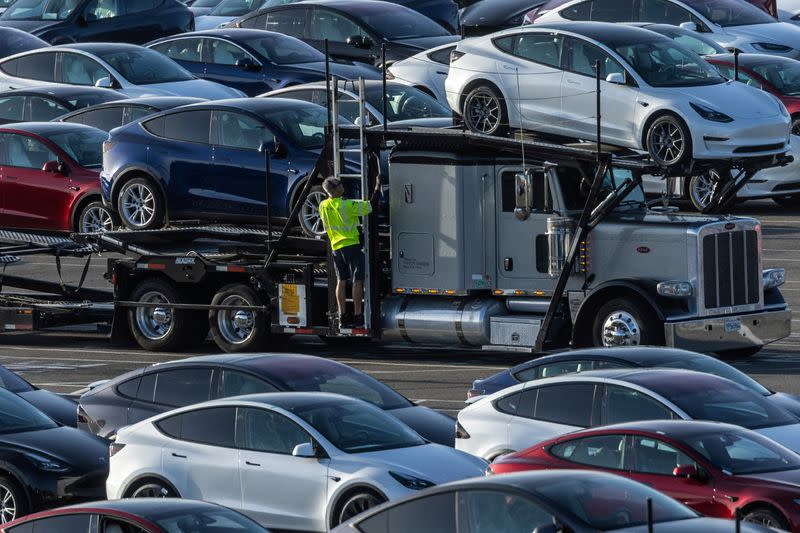Lithium iron phosphate batteries have become the preferred battery for electric vehicles as carmakers rush to produce cheaper cars.
Batteries are the most expensive components in EVs and lithium iron phosphate (LiFePO4 or LFP) batteries are popular partly because of environmental and geopolitical concerns.
Technological advances have also reduced the performance gap with more widely used materials such as nickel and cobalt.
LFP, embraced by EV industry leader Tesla two years ago, has sparked interest in the US, where a clutch of domestic and overseas manufacturers has pledged more than $14 billion in new production facilities.
Overseas, two of the world’s largest automakers, Toyota Motor and Hyundai Motor, have both announced plans in the past week to equip their future vehicles with LFP batteries, but have not disclosed plans for the US.
ALSO SEE:
China Extends $72bn Tax Break for Sale of EVs, Green Cars
Cheaper, ‘safer’ and easy to access in US
“LFP is less expensive than cobalt and nickel, and all the minerals can be obtained here in North America (which means) much lower transportation costs and a more secure supply chain,” said Stanley Whittingham, professor at Binghamton University in New York and a 2019 Nobel laureate for his work on lithium ion batteries.
The addition of manganese, a staple ingredient in rival nickel cobalt manganese (NCM) battery cells, has enabled lithium iron phosphate cells to hold more energy than previously, providing EVs with more range — up to 450 miles (724 km) on a single charge, Toyota said recently.
Michigan-based Our Next Energy, which is building a $1.6 billion battery manufacturing complex in Van Buren Township, is a proponent of LFP, according to founder and chief executive Mujeeb Ijaz, because “the materials are more abundant and sustainable, with far less risk” of fire.
“We’ve also demonstrated that you can match the range of cobalt cells with no compromise,” he said.
Tesla is among the automakers leading the quest in markets outside of China to provide lower-priced EVs – in Tesla’s case, targeting a base price of around $25,000. The use of LFP batteries should help Tesla and rivals to achieve that goal, experts say.
Ford Motor aims to open a $3.5 billion LFP cell manufacturing plant in western Michigan, leveraging technology licensed from China’s CATL, the world’s largest EV battery maker. The goal, Ford CEO Jim Farley said in February, is to lower the automaker’s cell costs to less than $70 a kilowatt-hour, from more than $100/kWh for current NCM cells.
Most LFP components come from China
More than 90% of LFP materials and components still come from China, battery expert Shirley Meng, a University of Chicago professor and head of Argonne National Laboratory’s Collaborative Center for Energy Storage Science, said.
The rapidly increasing adoption of LFP by EV manufacturers including Tesla and Hyundai suggests those companies “are not ready to decouple from China,” Meng said.
Battery expert Lukasz Bednarski, author of the 2021 book “Lithium: The Global Race for Battery Dominance and the New Energy Revolution,” believes automakers’ interest in building lower-priced EVs could be one of the drivers behind LFP’s rising popularity.
“LFP provides good enough performance at a lower cost, which makes it an attractive proposition for EVs for the middle class,” he said.
Bednarski added that the US Inflation Reduction Act (IRA) provides incentives “for the development of the whole battery chain (with no) preference for LFP chemistry.”
Rising investment in LFP manufacturing facilities in the United States is coming not just from domestic companies like Ford, ONE and General Motors.
Battery makers from Norway, Israel, South Korea and even China have committed to building US facilities to produce LFP materials, components and batteries, some of which will be used not in vehicles, but in large energy storage systems.
“LFP was invented in the US and first commercialized here,” said Whittingham. He said this happened before Chinese companies such as BYD and CATL “moved fast” to improve and deploy the technology, mainly in EVs.
Now, given its continued cost advantage over NCM, he added, LFP “should be used in all grid storage systems and lower-cost cars.”
- Reuters with additional editing by Jim Pollard
ALSO SEE:
Toyota Reveals Supercharged EV Battle Plan, New Battery Tech
Foxconn, Stellantis Join Forces in Auto Industry Chips JV
US Can’t Yet Compete With China on EVs, Ford Chairman Says
EV Boom Amps Up Costs, Environment Risk in China’s Lithium Hub
China’s EV Stars Leaving Global Auto Rivals in Their Wake






















